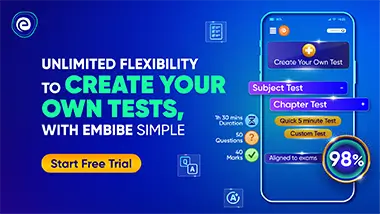Geometry
Practice Other Chapters from Geometry
This unit from EMBIBE-CHAPTER-WISE-PREVIOUS-YEAR-PAPERS-FOR-MATHEMATICS has 8 chapters to practice on Geometry
This chapter discusses theorems regarding angles in the segment of a circle. Useful theorems and information on the concept of angle subtended at the centre and in the circle, angle subtended at the centre by an arc are, etc., are also given here.
This chapter highlights theorems regarding cyclic quadrilateral. It also discusses useful theorems and information on opposite angles of a cyclic quadrilateral, and their applications through practice exercises.
This chapter emphasises theorems regarding tangents to a circle. The concept of a tangent, a transversal of a circle, direct common tangent, and common transverse tangent are explained here. Useful theorems and information are also provided here.
This chapter outlines theorems regarding similarity. Students will understand the concept of similar geometric figures. Useful theorems and information are provided here, along with their proofs. Suitable figures are also given for clarity.
This chapter features Pythagoras theorem. Useful theorems and information are provided here for our comprehension. Pythagoras theorem and converse of Pythagoras theorem are also discussed here through suitable figures.
This chapter provides knowledge of construction. Students will understand basic constructions, and construction of angles and triangle. Construction of circles and special type of quadrilaterals here.
This chapter introduces students to the concept from the figure by application of theorems, to find the value of geometric quantities. They will also learn how to find quantities such as angle, length of a line segment, etc.

